Related Research Articles
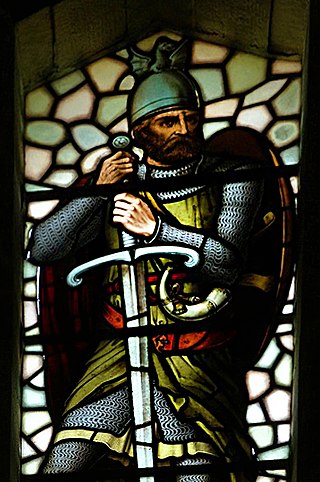
Sir William Wallace was a Scottish knight who became one of the main leaders during the First War of Scottish Independence.
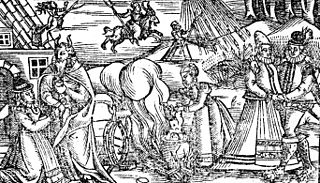
Isobel Gowdie was a Scottish woman who confessed to witchcraft at Auldearn near Nairn during 1662. Scant information is available about her age or life and, although she was probably executed in line with the usual practice, it is uncertain whether this was the case or if she was allowed to return to the obscurity of her former life as a cottar’s wife. Her detailed testimony, apparently achieved without the use of violent torture, provides one of the most comprehensive insights into European witchcraft folklore at the end of the era of witch-hunts.
Fairyland in English and Scottish folklore is the fabulous land or abode of fairies or fays. Old French faierie referred to an illusion or enchantment, the land of the faes. Modern English fairy transferred the name of the realm of the fays to its inhabitants, e.g. the expression fairie knight in Edmund Spenser's The Faerie Queene refers to a "supernatural knight" or a "knight of Faerie" but was later re-interpreted as referring to a knight who is "a fairy".
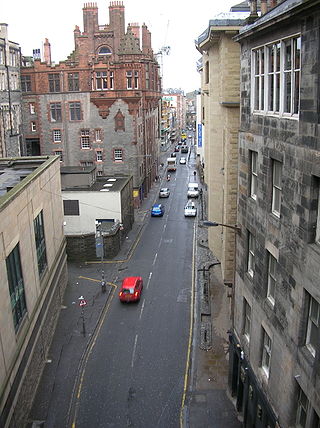
The Cowgate is a street in Edinburgh, Scotland, located about 550 yards (500 m) southeast of Edinburgh Castle, within the city's World Heritage Site. The street is part of the lower level of Edinburgh's Old Town, which lies below the elevated streets of South Bridge and George IV Bridge. It meets the Grassmarket at its west end and Holyrood Road to the east.

Robert Wodrow was a Scottish minister and historian, known as a chronicler and defender of the Covenanters. Robert Wodrow was born at Glasgow, where his father, James Wodrow, was a professor of divinity. Robert was educated at the university and was librarian from 1697 to 1701. From 1703 till his death, he was parish minister at Eastwood, near Glasgow. He had sixteen children, his son Patrick being the "auld Wodrow" of Burns's poem Twa Herds.
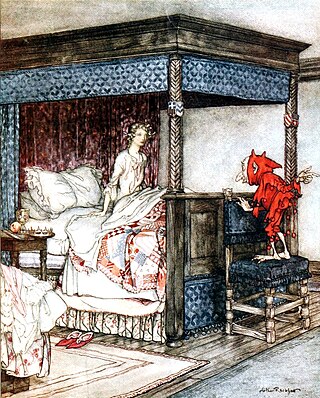
Billy Blind is an English and Lowland Scottish household spirit, much like a brownie. He appears only in ballads, where he frequently advises the characters. It is possible that the character of Billy Blind is a folk memory of the god Woden or Odin from Germanic mythology, in his "more playful aspect" and is speculated to have been the same character as Blind Harie, the "blind man of the game" in Scotland.

The Chair of Scottish History and Literature at the University of Glasgow was founded in 1913, endowed by a grant from the receipts of the 1911 Scottish Exhibition held in Glasgow's Kelvingrove Park, as well as donations from the Merchants House of Glasgow and other donors. The chair has been held by a number of prominent historians of Scotland, including two Historiographers Royal. Although the chair is now based within the Department of History, it retains its original title.
The 1884 Home Nations Championship was the second series of the rugby union Home Nations Championship. Six matches were played between 5 January and 12 April 1884. It was contested by England, Ireland, Scotland, and Wales.
The 1883 Home Nations Championship was the inaugural series of the rugby union Home Nations Championship. Five matches were played between 16 December 1882 and 3 March 1883. It was contested by England, Ireland, Scotland, and Wales.

Janet Horne was the last person to be executed legally for witchcraft in the British Isles.
Edward James Cowan FRSE was a Scottish historian.
Robert Kirk was a minister, Gaelic scholar and folklorist, best known for The Secret Commonwealth, a treatise on fairy folklore, witchcraft, ghosts, and second sight, a type of extrasensory perception described as a phenomenon by the people of the Scottish Highlands. Folklorist Stewart Sanderson and mythologist Marina Warner called Kirk's collection of supernatural tales one of the most important and significant works on the subject of fairies and second sight. Christian philosopher and religious studies scholar David Bentley Hart has praised Kirk for writing The Secret Commonwealth to defend "harmless Scottish country folk who innocently dabbled in the lore of their culture" and "found themselves arraigned by Presbyterian courts for practicing the black arts."
Events from the year 1805 in Scotland.

Childhood in Medieval Scotland includes all aspects of childhood within the geographical area that became the Kingdom of Scotland, from the end of Roman power in Great Britain, until the Renaissance and Reformation in the sixteenth century.

The Pittenweem witches were five Scottish women accused of witchcraft in the small fishing village of Pittenweem in Fife on the east coast of Scotland in 1704. Another two women and a man were named as accomplices. Accusations made by a teenage boy, Patrick Morton, against a local woman, Beatrix Layng, led to the death in prison of Thomas Brown, and, in January 1705, the murder of Janet Cornfoot by a lynch mob in the village.

Margaret Aitken, known as the Great Witch of Balwearie, was an important figure in the great Scottish witchcraft panic of 1597 as her actions effectively led to an end of that series of witch trials. After being accused of witchcraft Aitken confessed but then identified hundreds of women as other witches to save her own life. She was exposed as a fraud a few months later and was burnt at the stake.

The Bute witches were six Scottish women accused of witchcraft and interrogated in the parish of Rothesay on Bute during the Great Scottish Witch Hunt of 1661–62. The Privy Council granted a Commission of Justiciary for a local trial to be held and four of the women – believed by historians to be Margaret McLevin, Margaret McWilliam, Janet Morrison and Isobell McNicoll – were executed in 1662; a fifth may have died while incarcerated. One woman, Jonet NcNicoll, escaped from prison before she could be executed but when she returned to the island in 1673 the sentence was implemented.
Janet Boyman, also known as Jonet Boyman or Janet Bowman, was a Scottish woman accused of witchcraft; she was tried and executed in 1572 although the case against her was started in 1570. Her indictment has been described by modern-day scholars, such as Lizanne Henderson, as the earliest and most comprehensive record of witchcraft and fairy belief in Scotland.
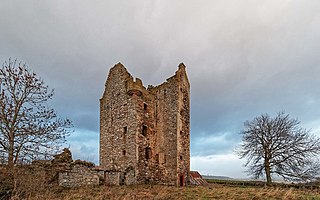
Fairburn Tower is a recently restored Scottish castle near Inverness and Muir of Ord in the parish of Urray.
The Witches of Bo'ness were a group of women accused of witchcraft in Bo'ness, Scotland in the late 17th century and ultimately executed for this crime. Among the more famous cases noted by historians, in 1679, Margaret Pringle, Bessie Vickar, Annaple Thomsone, and two women both called Margaret Hamilton were all accused of being witches, alongside "warlock" William Craw. The case of these six was "one of the last multiple trials to take place for witchcraft" in Scotland.
References
- ↑ "Dr Lizanne Henderson on German visit". University of Glasgow. 18 June 2008. Retrieved 26 February 2011.[ dead link ]